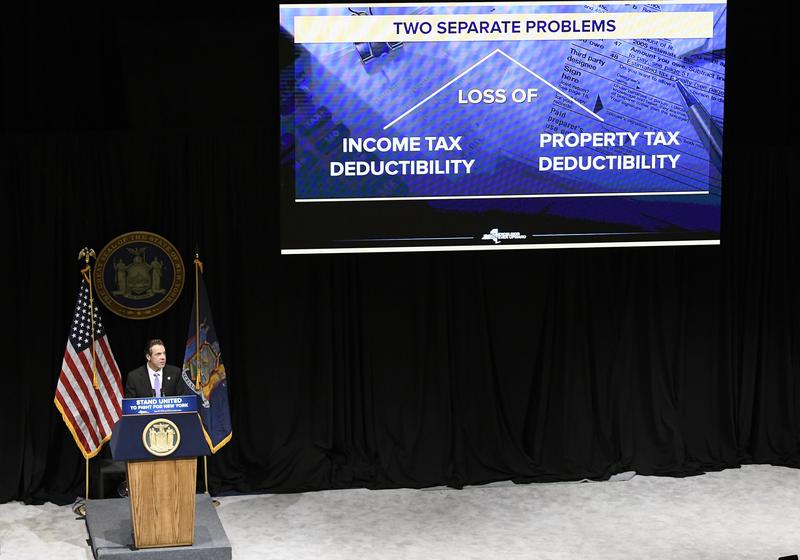
You might think 2018 just began, but for New York, it's winding down. The state's next fiscal year starts in three months.
On Tuesday, Gov. Andrew Cuomo proposed a $168 billion budget for 2019 that will surely have many moving parts between now and the end of March. Here are five takeaways:
1. Cuomo wants to build an elaborate contraption to out-maneuver what he says is a massive federal tax hike.
New Yorkers pay relatively high taxes, but a saving grace has been the ability to deduct them from federal returns — a benefit that disappeared when President Trump signed into law the GOP tax overhaul. To buffer taxpayers from this new shock, Cuomo is proposing a radical restructuring of the state tax code. Employers for whom it would be worthwhile would pay their workers' federal taxes as a payroll obligation. These businesses could still do what individuals no longer can: deduct the taxes. Employees would literally get a salary cut, but by being relieved of the tax liability, they would come out ahead. Property taxes would be trickier, with towns, cities and counties creating charitable 'foundations' into which taxpayers would 'donate' payments in lieu of taxes and then take a deduction. Cuomo said this all passes legal muster, but it's a safe bet the Trump administration would challenge the work-around. Request for comment from White House spokespersons went unanswered.
2. Republicans DON'T.
If the governor is so concerned about taxes, let him reduce them, say GOP politicians and conservative commentators. "Even before the latest tax changes, people were leaving because the taxes are too high," said Sen. John DeFrancisco (R-Syracuse), the deputy majority leader. "[Cuomo] says our only hope is lawsuits and changing the tax structure. Well, there's another concept: cutting spending." Others said Cuomo and Democrats are crying about the sky falling, and that the lost deductibility will harm relatively few people. They pointed to an analysis by the Partnership for NYC that suggests the average New Yorker in most income classes will see net taxes go down, even after the longstanding write-offs largely disappear.
3. Cuomo faces a $4 billion budget deficit, but does not envision widespread sacrifice.
"Spending cuts" for government never mean cuts — they mean reducing the rate of growth. New York's budget would still grow close to $2 billion — or 2 percent, from $100 billion. The budget for the two biggest sectors, Medicaid and primary education, will grow around 3 percent. To make up for the shortfall, Cuomo would be less generous with non-educational funding for localities. And he's proposed a bevvy of "revenue raisers," including the elimination of sales tax exemptions for alternatively sourced power providers, the deferral of a tax credit for large companies and a crackdown on e-tailers that don't charge purchasers sales tax.
4. The waters ahead will be especially choppy for the health plans and health care providers.
The Children's Health Insurance Plan has expired, Medicaid funding for safety-net hospitals is expected to decline, and other Medicaid funds are in jeopardy that allow New York to provide almost free coverage for people who would otherwise be insured on the state's Affordable Care Act exchange. To shore up Medicaid against a looming storm, Cuomo wants to establish a "Shortfall Fund." Money would come from a higher tax on health insurers and a two-cent-per-milligram tax on opioids. Cuomo also wants the Health Department to investigate legalizing the sale of marijuana, a step that elected leaders in both Massachusetts and New Jersey are contemplating.
5. The tradition of putting non-fiscal items in the budget is alive and well.
The back of Cuomo 'budget briefing book' includes a lengthy list of "Legislation Required for the Budget." Many of these items are hot-button policy initiatives that progressive love, including anti-harassment measures, expanded voter access, term limits and campaign finance reform. They're included in the budget because that's where the leverage is — but they've consistently fallen through the cracks once Cuomo has rolled up his sleeves to negotiate with the top leaders of the Assembly and Senate.
